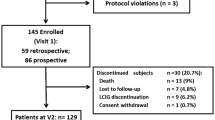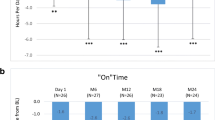Abstract
Many studies confirmed the efficacy and safety of continuous infusion of intrajejunal levodopa/carbidopa gel (CIILG) for advanced Parkinson’s disease (PD). Although this treatment is widely used, definite inclusion/exclusion criteria do not exist. In this prospective open-label study, we evaluated the long-term outcome in 28 consecutive patients and sought to detect any predictive factor to identify the best candidates for CIILG therapy. The assessment was carried out routinely at baseline, after 6 months and every year with UPDRS III–IV, FOG Questionnaire, non-motor symptoms scale, PD questionnaire (PDQ-8), cognitive and psychiatric status evaluation (MMSE, FAB, NPI) and caregiver’s quality of life. 17/28 patients reached the 24-month follow-up. A statistically significant beneficial effect was shown on motor complications in short- and long-term follow-up, also on axial symptoms like gait disturbances. A concomitant improvement in PDQ8 score was observed, with a parallel mild amelioration, but not significant, on Caregivers QoL. When classified according to their outcome on QoL, the only predictive positive factor was less severe at Neuropsychiatric Inventory (NPI) score at baseline. Considering the improvement in motor scores (duration of “off” period), the more advanced age was associated with a poorer outcome. Our results confirmed a sustained efficacy and safety in long-term follow-up and suggest that younger age at operation and absence or mild presence of psychiatric/behavioural symptoms could be considered valid predicting factors in selecting the best candidates for this efficacious therapy.


Similar content being viewed by others
References
Aarsland D, Andersen K, Larsen JP et al (2004) The rate of cognitive decline in Parkinson disease. Arch Neurol 61:1906–1911
Aarsland D, Brønnick K, Ehrt U (2007) Neuropsychiatric symptoms in patients with Parkinson’s disease and dementia: frequency, profile and associated care giver stress. J Neurol Neurosurg Psychiatry 78:36–42. doi:10.1136/jnnp.083113
Antonini A, Tolosa E (2009) Apomorphine and levodopa infusion therapies for advanced Parkinson disease: selection criteria and patient management. Expert Rev Neurother 9(6):859–867
Antonini A, Isaias IU, Canesi M et al (2007) Duodenal levodopa infusion for advanced Parkinson’s disease: 12-month treatment outcome. Mov Disord 22:1145–1149
Antonini A, Mancini F, Canesi M et al (2008) Duodenal levodopa infusion improves quality of life in advanced Parkinson’s disease. Neurodegenerative Dis 5(3–4):244–246
Antonini A, Odin P, Lopiano L (2013) Effect and safety of duodenal levodopa infusion in advanced Parkinson’s disease: a retrospective multicenter outcome assessment in patient routine care. J Neural Transm. doi:10.1007/s00702-013-1026-9
Chaudhuri KR, Jose Rojo JM, Schapira AHV et al. (2013). A proposal for a comprehensive grading of Parkinson’s disease severity combining motor and non-motor assessments: meeting an unmet need. PLOS ONE www.plosone.org 8 (2): e57221
DANMODIS, Danish Movement Disorder Society; SWEMODIS, Swedish Movement Disorder Society (2008) Duodopa: Scandinavian Consensus I. Treatment with levodopa/carbidopa gel (Duodopa) in patients with Parkinson’s disease, Available at: http://info.parkinsonforbundet.se/wpcontent/uploads/duodopakonsensus-20081.pdf
Defer GL, Widner H, Rose- M et al (1999) Core assessment program for surgical interventional therapies in Parkinson’s disease (CAPSIT-PD). Mov Disord 14(4):572–584
Devos D (2009) Patient profile, indications, efficacy and safety of duodenal levodopa infusion in advanced Parkinson’s disease. Mov Disord 24(7):993–1000
Eggert K, Sckwrader C, Habner M et al (2008) Continuous jejunal levodopa infusion in patients with advanced Parkinson disease: practical aspects and outcome of motor and non-motor complications. Clin Neuropharmacol 31(3):151–166
Fasano A, Ricciardi L, Lena F et al (2012) Intrajejunal levodopa Infusion in advanced Parkinson’s disease: long-term effects on motor and non-motor symptoms and impact on patient’s and caregiver’s quality of life. Eur Rev Med Pharmacol Sci 16(1):79–89
Fernandez HH, Vanagunas B, Odin P et al (2013) Levodopa–carbidopa intestinal gel in advanced Parkinson’s disease open-label study: Interim results. Parkinsonism Relat Disord 19:339–345
Glozman JM, Bicheva KG, Fedorova NV (1998) Scale of quality of life of care-givers (SQLC). J Neurol 245(Suppl 1):S39–S41
Hindle V (2013) The practical management of cognitive impairment and psychosis in the older Parkinson’s disease patient. J Neural Transm 120:649–653
Honig H, Antonini A, Martinez PP et al (2009) Intrajejunal levodopa infusion in Parkinson’s disease: a pilot multicenter study of effects on non-motor symptoms and quality of life. Mov Disord 24(10):1468–1474
Johansson A, Nyholm D (2012) Continuous delivery of energy or l-dopa: identifying advantages and limitations of DBS and levodopa–carbidopa intestinal gel in the absence of head-to-head comparisons. Basal Ganglia 2:221–226
Kulisevsky J, Pagonabarraga J, Pascual-Sedano B et al (2008) Prevalence and correlates of neuropsychiatric symptoms in Parkinson’s disease without dementia. Mov Disord 23(13):1889–1896
Kurth MC, Tetrud JW, Tanner CM et al (1993) Double-blind, placebo-controlled, crossover study of duodenal infusion of levodopa/carbidopa in Parkinson’s disease patients with “on–off” fluctuations. Neurology 43:1698–1703
Nyholm D (2012) Duodopa treatment for advanced Parkinson’s disease: a review of efficacy and safety. Parkinsonism Relat Disord ep 18(8):916–929
Nyholm D, Askmark H, Gomes-Trolin C et al (2003) Optimizing levodopa pharmacokinetics: intestinal infusion versus oral sustained-release tablets. Clin Neuropharmacol 26(3):156–163
Nyholm D, Nilsson Remahl AIM, Dizdar N et al (2005) Duodenal levodopa infusion monotherapy vs oral polypharmacy in advanced Parkinson disease. Neurology 64(2):216–223
Nyholm D, Lewander T, Johansson A et al (2008) Enteral levodopa/carbidopa infusion in advanced Parkinson disease: long-term exposure. Clin Neuropharmacol 31(2):63–73
Nyholm D, Klangemo K, Johansson A (2012) Levodopa/carbidopa intestinal gel infusion long-term therapy in advanced Parkinson’s disease. Eur J Neurol. doi:10.1111/j.1468-1331.201203679.x
Palhagen SE, Dizdar N, Hauge T et al (2012) Interim analysis of long-term intra-duodenal levodopa infusion in advanced Parkinson disease. Neurol Scand. doi:10.1111/j.1600-0404.2012.01689
Puente V, De Fabregues O, Oliveras C et al (2010) Eighteen month study of continuous intra-duodenal levodopa infusion in patients with advanced Parkinson’s disease: impact on control of fluctuations and quality of life. Parkinsonism Relat Disord 16(3):218–221
Reddy P, Martinez-Martin P, Rizos A, Martin A et al (2012) Intrajejunal levodopa versus conventional therapy in Parkinson disease: motor and non-motor effects. Clin Neuropharmacol 35(5):205–207
Robottom BJ, Gruber- Baldini AL, Anderson KE et al (2012) What determines resilience in patients with Parkinson’s disease? Parkinsonism Relat Disord 18:174–177
Sánchez-Castañeda C, Jaume Campdelacreu J, Miró J et al (2010) Cognitive improvement after duodenal levodopa infusion in cognitively impaired Parkinson’s disease patients. Prog Neuro Psychopharmacol Biol Psychiatry 34:250–251
Santos-Garcia D, Anon MJ, Fuster-Sanjurjo L, de la Fuente-Ferna′ndez R (2012) Duodenal levodopa/carbidopa infusion therapy in patients with advanced Parkinson’s disease leads to improvement in caregivers’ stress and burden. Eur J Neurol 19(9):1261–1265
Schrag A, Hovris A, Morley D et al (2006) Caregiver-burden in Parkinson’s disease is closely associated with psychiatric symptoms, falls and disability. Parkinsonism Relat Disord 12:35–41
Schuepbach WMM, Rau J, Knudsen K et al (2013) Neuro-stimulation for Parkinson’s disease with early motor complications. New Engl J Med 368:610–622
Valldeoriola F, Puig-Junoy J, Puig-Peiró R, Workgroup of the SCOPE study (2013) Cost analysis of the treatments for patients with advanced Parkinson’s disease: SCOPE study. J Med Econ 16(2):191–201. doi:10.3111/13696998.2012.737392 (Epub 2012 Oct 29)
Volkmann J, Albanese A, Antonini A et al (2013) Selecting deep brain stimulation or infusion therapies in advanced Parkinson’s disease: an evidence-based review. J Neurol. doi:10.1007/s00415-012-6798-6
Westin J, Nyholm D, Groth D et al (2006) Outcome prediction of enteral levodopa/carbidopa infusion in advanced Parkinson’s disease. Parkinsonism Relat Disord 12:509–513
Zibetti M, Merola Z, Ricchi V et al (2013) Long-term duodenal levodopa infusion in Parkinson’s disease: a 3-year motor and cognitive follow-up study. J Neurol 260(1):105–114
Conflict of interest
Mariachiara Sensi has received lecture fees and payment for advisory boards from Abbott, Boehringer Ingelheim, Lundbeck, UCB, Merck Serono. Rocco Quatrale has received lecture fee, payments for advisory boards from Abbott, Boehringer Ingelheim, Novartis, Lundbeck, UCB, Merck Serono, Chiesi, GSK. Francesca Preda has received consultancy fees from Medtronic.
Author information
Authors and Affiliations
Corresponding author
Rights and permissions
About this article
Cite this article
Sensi, M., Preda, F., Trevisani, L. et al. Emerging issues on selection criteria of levodopa carbidopa infusion therapy: considerations on outcome of 28 consecutive patients. J Neural Transm 121, 633–642 (2014). https://doi.org/10.1007/s00702-013-1153-3
Received:
Accepted:
Published:
Issue Date:
DOI: https://doi.org/10.1007/s00702-013-1153-3




